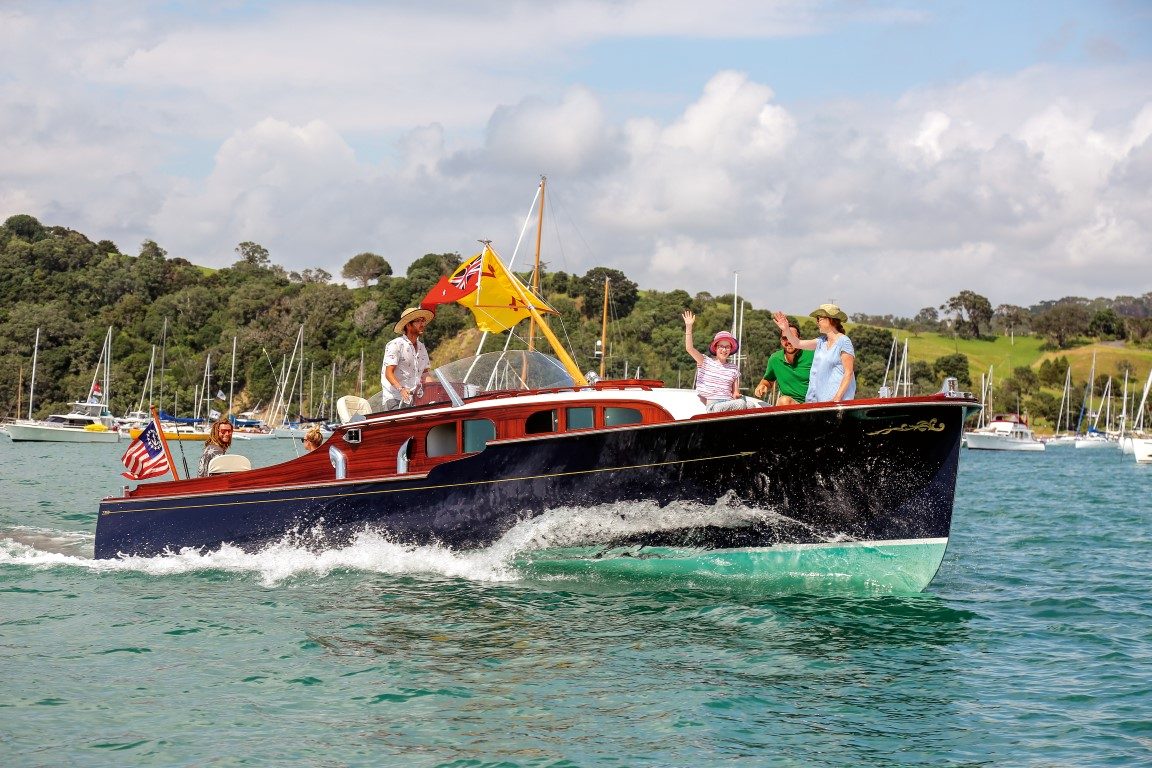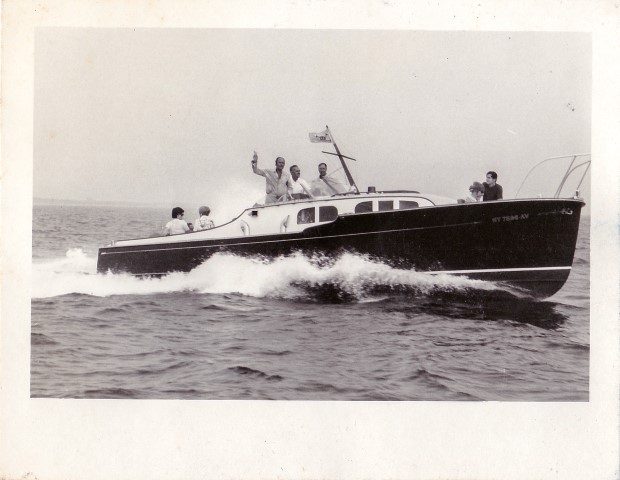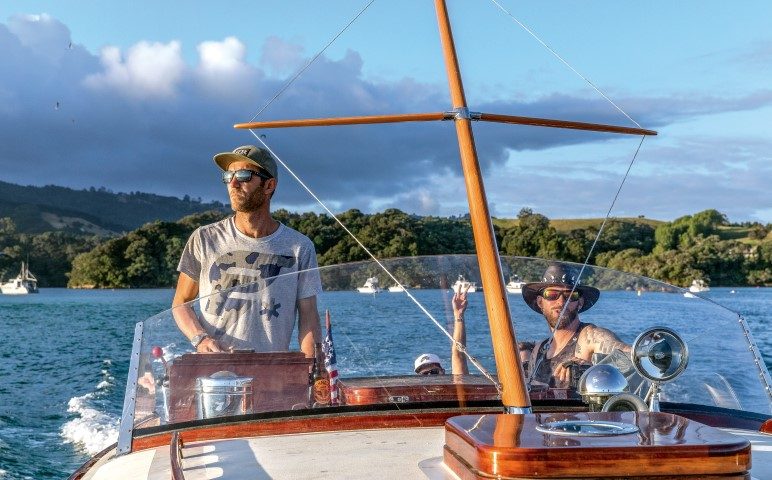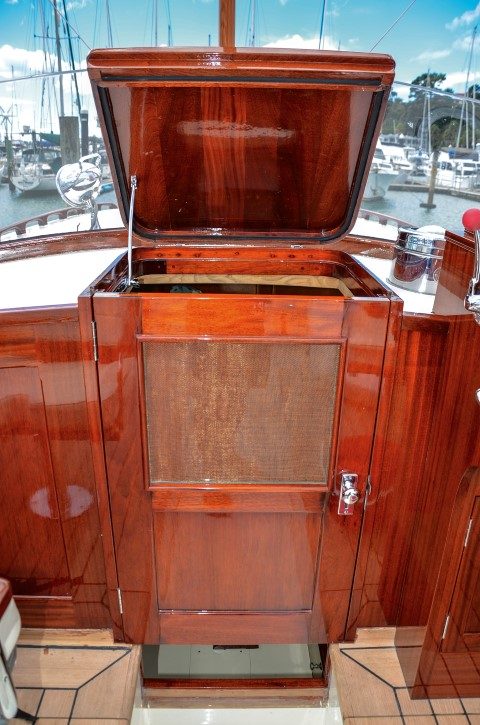

Built in 1949 by the legendary Lüders Marine Corporation in Connecticut, Laughing Lady was recently relaunched at Omaha after years of neglect and a glorious restoration by the Whangateau Boat Yard.
Her gleaming brightwork is offset by period fittings and fixtures – and though she boasts a few modern accessories such as a chartplotter, these are discreetly-mounted, hidden and out of sight until needed. So she looks pretty much as she did when first launched.

Perhaps the most intriguing part of her restoration is the research that went into the project. Her owners – brothers James and Michael Dreyer, together with George Emtage and Pam Cundy at the boatyard – had very little to work with by way of original plans or photos. Finding this information took sleuth work, quite a bit of intuition, and a lot of luck.
I’ll get to the restoration in a minute, but first some background.
A 33-foot sports fishing boat, Laughing Lady was built for a Mrs Winthrop Bailey – a wealthy American socialite who hob-nobbed with British royalty. The boat was associated with the glamour set from the get-go – and it’s easy to sense that her name was eminently appropriate.
She was built for speed – her double-planked cedar and mahogany hull, wrapped around oak framing, was powered by twin, straight-eight 150hp Packard engines giving her a speed of nearly 30 knots.
Mrs Bailey sold the boat to a New York stockbroker, Robert David Lion Gardiner. He owned Gardiner’s Island, at the eastern tip of Long Island, and he used Laughing Lady to commute from his home to Greenport, on Long Island. From there it was a quick rail trip into midtown Manhattan. He also used her to ferry guests between his island and the upmarket Hamptons – where the Who’s Who of Long Island kept their holiday mansions.

When Gardiner died in 2004 the boat was sold to a distant relative in California. But the road trip across the US was catastrophic and she arrived with a broken back and one of her engines hanging off the transom.
It fell to a San Diego boatyard – Traditional Boat Works – to tackle the forlorn and fallen lady’s mammoth rebuild. All progressed well for a few years, but the 2008 GFC put the brakes on the project. The boatyard eventually acquired the boat in lieu of unpaid bills. And there she lay, gathering dust, for many years, until she was spotted by James Dreyer – an avid Kiwi classic boat enthusiast.
ACQUISITION
In his day job James is chief officer of a 92m private yacht in the Mediterranean, and when not in skippering mode he spends time in the San Diego, working on restoring a small, one-design Rhodes cutter.

“Laughing Lady was lying – abandoned – next to my boat. And every time I took a tea-break from my project, I’d find myself staring at the old launch and her beautiful lines. I knew the boatyard owner – Doug Jones – really well and when he suddenly announced he was shifting to Seattle, he suggested I buy Laughing Lady: ‘I know you love her. Do the right thing.’
“So we came to an arrangement. I acquired her and decided to ship her to New Zealand to complete her restoration. And that’s how she ended up at the Whangateau Boat Yard.”
THE SHERLOCK TEAM
James was committed to returning Laughing Lady to her original condition, but with nothing to work from, his vision ran into obstacles immediately.
“A huge fire in the Lüders yard in the early 60s destroyed the plans of all its boats. In desperation I visited the nearby Mystic Seaport Museum, but all it had was a small Lüders folder with half a dozen sheets – and zilch about Laughing Lady.”
Pam, in the meantime, was doing her own bit of sleuthing – extrapolating clues for the probable layout of the boat’s (missing) interior, working from fastener holes in the frames, little bits of handrail and a few surviving fittings.

James’ investigations took him to Gardiner’s Island, where he was introduced to an elderly mechanic at the local marina. He unearthed a photo of Laughing Lady’s mangled props – Gardiner had run her aground. But the image also provided valuable details about the design of her rub rail.
James also knew that in the early 60s the New York Times (NYT) had run an article – The Greatest Picnic the World has ever Seen. It covered a high-society picnic on Gardiner’s Island – catered for by President John Kennedy’s personal chef, Charles De Gaulle’s personal chef, as well as chefs from the top Michelin star restaurants in Paris and New York. The writer was the NYT’s food critic.

Chefs and guests had all been ferried to the island on Laughing Lady, and James wondered what had happened to the press photos. Weirdly, Fate dealt him a friendly hand.
“I’d booked an AirBnB on the island, and it transpired that the owner had lived in the area all her life. She knew a lot about the Gardiner family and used to travel in Laughing Lady as a child. Incredibly, her father had been the NYT food critic – and she produced a photo album with a magnificent selection of 8×10-inch glossy images.”
The images provided detailed information about Laughing Lady – and most remarkably, they showed that Pam’s interpretation and extrapolation had been spot on!

A final piece in the puzzle came – of all places – from Norway. “I received a random email, out of the blue, from a chap who said he had plans for Laughing Lady. I said that’s impossible – the plans had gone up in flames. Well, he said, I bought a folder of Lüders concept drawings on eBay 10 years ago – and it contained many plans, including those for Laughing Lady. And he sent them to me.”

If uncovering the details of Laughing Lady’s original design was tough, finding the mahogany to complete the restoration proved equally challenging. Honduras mahogany is a CITES-protected timber and unobtainable. Much of Laughing Lady’s structural rebuild has used sapele mahogany, but James’ trawl through TradeMe also produced some useful – if unorthodox – pickings for the brightwork.
“We found a large beam of mahogany which we used for the cockpit. But I must sheepishly confess I also bought a few old dining room suites. The sellers weren’t always impressed when I mentioned I’d be cutting them up!”
ENGINES
Laughing Lady was originally powered by a pair of 150hp, 356 cubic-inch, straight-eight Packard petrol engines. Gardiner swapped these in the late 80s for a pair of 165hp, six-cylinder, turbo-charged Volvo diesels – weighing half as much.
They’d only clocked up 150 hours before the boat’s unfortunate trip to San Diego. Still, James opted to have the Volvos completely overhauled, and says the team of specialists who helped to get the engines running were fantastic.

“Hadlee and Lachlan at Auckland’s Ovlov Marine were absolute legends. They helped with sourcing hard-to-find parts – both secondhand and new – and offered advice freely. Pakuranga Radiators and Vermont Radiators both have huge experience with Volvo cooling systems.
“Torbay’s Diesel Injector Services has got to be the friendliest injector and fuel pump specialist in Auckland – and Steve Murch, at Motorsport Engineering – is a turbo guru. When it came to cranking the engines over for the first time in years, a specialist Volvo mechanic from Matakana Marine was hovering nearby for my peace of mind should something go wrong. Incredibly, both engines fired up after a short crank and ran beautifully. They power the boat to about 28 knots.”

Laughing Lady, says James, will be used as a family day boat, and perhaps for some fishing. The original bronze games chairs have survived and, after re-chroming and re-upholstering, are a dominant cockpit feature. She’s alluring, sleek, mysterious – and if you listen carefully, over the purr of the Volvos you might just hear the lady laughing again.




